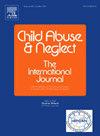儿童和青少年的虐待与执行功能——一项多水平荟萃分析。
IF 3.4
2区 心理学
Q1 FAMILY STUDIES
引用次数: 0
摘要
背景:儿童虐待与认知发展缺陷有关,特别是在核心执行功能(EF、认知灵活性、抑制控制、工作记忆)方面。然而,由于有限的荟萃分析证据,CM维度(滥用、忽视)是否与核心英语发展存在差异尚不清楚。目的:我们进行了一项预先注册的荟萃分析,比较受虐待和未受虐待儿童和青少年的核心EF表现,检查CM维度、亚型、样本和研究相关特征作为潜在的调节因素。方法:系统检索PsycINFO和PubMed(2022年5月,2023年3月更新),根据预注册标准确定符合条件的同行评议研究。我们进行了多水平混合效应荟萃分析,包括亚组分析,以探索EF域和CM维度作为调节因子。其他调节因素(年龄、女性比例、CM亚型、研究质量)通过meta回归进行检验。采用漏斗图和Egger检验评估发表偏倚。参与者和环境:我们纳入了59项研究,有92种效应量,包括13022名个体(MAge = 12.0岁,SD = 2.8; 50.2%为女性)。结果:被虐待的个体表现出中度的EF域缺陷(Hedge’s g = -0.43, 95% CI [-0.53, -0.34], p)。结论:我们的研究结果表明CM和EF域缺陷之间存在累积的、多重的关系。然而,研究中观察到的大量异质性和有限的方法学细节限制了这一结论。不同的虐待经历如何影响EF的发展需要进一步的研究来阐明。本文章由计算机程序翻译,如有差异,请以英文原文为准。
Maltreatment and executive functioning in childhood and adolescence − A multilevel meta-analysis
Background
Child maltreatment (CM) is associated with deficits in cognitive development, particularly in core executive functioning (EF; cognitive flexibility, inhibitory control, working memory). However, due to limited meta-analytic evidence, it remains unclear whether CM dimensions (abuse, neglect) differentially relate to core EF development.
Objective
We conducted a pre-registered meta-analysis on studies comparing core EF performance between maltreated and nonmaltreated children and adolescents, examining CM dimensions, subtypes, sample-, and study-related characteristics as potential moderators.
Methods
A systematic search in PsycINFO and PubMed (May 2022, updated March 2023) identified eligible peer-reviewed studies per pre-registered criteria. We conducted a multilevel mixed-effects meta-analysis, including subgroup analyses to explore EF domains and CM dimensions as moderators. Additional moderators (age, female ratio, CM subtypes, study quality) were examined via meta-regressions. Publication bias was assessed using funnel plots and Egger's test.
Participants and setting
We included 59 studies with 92 effect sizes, comprising 13,022 individuals (MAge = 12.0 years, SD = 2.8; 50.2 % female).
Results
Maltreated individuals showed moderate EF deficits across domains (Hedge's g = −0.43, 95 % CI [−0.53, −0.34], p < .001), with substantial heterogeneity (Q(91) = 390.57, p < .001), partially explained by EF domain differences. CM dimensions did not explain this heterogeneity, whereas sex emerged as a significant moderator.
Conclusions
Our findings suggest a cumulative, multifinal relationship between CM and EF domain deficits. However, the substantial heterogeneity observed across studies and limited methodological details constrain this conclusion. Further research is needed to elucidate how different maltreatment experiences impact EF development.
求助全文
通过发布文献求助,成功后即可免费获取论文全文。
去求助
来源期刊

Child Abuse & Neglect
Multiple-
CiteScore
7.40
自引率
10.40%
发文量
397
期刊介绍:
Official Publication of the International Society for Prevention of Child Abuse and Neglect. Child Abuse & Neglect The International Journal, provides an international, multidisciplinary forum on all aspects of child abuse and neglect, with special emphasis on prevention and treatment; the scope extends further to all those aspects of life which either favor or hinder child development. While contributions will primarily be from the fields of psychology, psychiatry, social work, medicine, nursing, law enforcement, legislature, education, and anthropology, the Journal encourages the concerned lay individual and child-oriented advocate organizations to contribute.
 求助内容:
求助内容: 应助结果提醒方式:
应助结果提醒方式:


